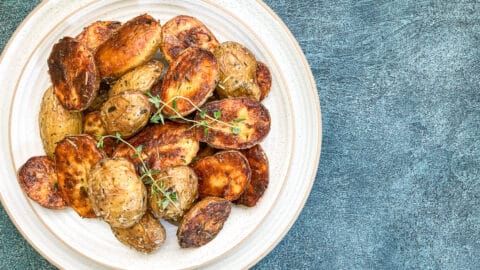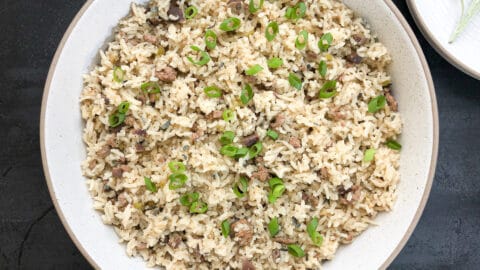This prime rib is cooked to perfection in a rich butter herb mixture and finished in a delicious red wine sauce. It’s served with a side of herb garlic mashed potatoes and crisp sauteed green beans for the ultimate prime rib dinner menu.

Cooking prime rib in the comfort of your home is actually easier than you think. There's no marinating involved or other special prepping techniques.
With the holidays only a few days away, this delectable cut of meat will most likely grace many dinner tables.
Whether it's you and your partner or a small group of 4 to 5 people, I hope this recipe, or these Rosemary Marinated Lamb Loin Chops, this Tri-Tip, or this Dutch Oven Cajun Turkey Breast will inspire you to cook a special meal that brings joy to your heart.
If you're cooking a traditional Thanksgiving or Christmas dinner, you'll love this Garlic Butter Herb Roasted Turkey Recipe or Roasted Cornish Hen Recipe in White Wine Sauce.
Jump to:
What is prime rib (standing rib roast)?
Prime rib is an excellent cut of steak that comes from the primal rib section of the cow.
It is well-marbled which simply means that it has a good amount of fat that runs throughout the meat. The amount of marbling makes for a tender, juicy, and flavorful cut of meat. In other words, as the fat renders during the cooking process, it naturally bastes the prime rib making it extra moist and soft.
Prime rib is the entire rib roast which you can buy either bone-in or boneless; however, bone-in will provide you with the juiciest and most mouthwatering bite. So, I will say to choose one with the bone-in which may be a little less expensive than boneless.
It's worth noting that although prime rib contains the word prime does not mean that it is considered USDA prime beef; therefore, before purchasing, double check with the butcher to ensure that you're getting the quality of meat that you're expecting.
If you're interesting in learning the differences between Prime Rib and Ribeye, check out this article.
Equipment
For this recipe I used a cast iron skillet but any oven safe-skillet or small roasting pan will work. Nothing too big so the pan juices do not spread too much.
How to cook prime rib

- Combine butter-herb mixture (not shown and set aside.
- Cut shallots into large pieces and place in cast iron skillet along with whole garlic cloves and fresh rosemary.

- Wash and pat dry with paper towels.
- Smear a generous amount of butter-herb mixture over the fat cap, and the remaining mixture over the surface of the prime rib.
- Season liberally with kosher salt and black pepper and place in the skillet bone side down on top of the bed of shallots and garlic.

Preheat oven to 450 degree F and place prime rib into oven for 25 minutes then lower to 325 degrees F until desired doneness.

Remove the prime rib from the oven and place on a clean plate, platter to rest, or cutting board and loosely cover with foil paper.
Note: Allow the roast to rest about 20 minutes before slicing.
Prepare the sauce
- Place the same skillet on the stove top, remove the rosemary from the skillet and discard.
- Drain the excess grease from the skillet keeping the remaining drippings including the cooked shallots and garlic.
- Add ½ cup of beef broth PLUS ½ cup of dry red wine to the skillet and bring to a gentle boil.
- Reduce the heat and simmer for 15 to 20 minutes until sauce reduces.
- Place a sieve over a gravy bowl or small bowl and run the sauce through to catch the shallots and garlic and discard.
- Use the sauce as a dipping sauce or drizzle over the top of the prime rib.
Determining internal temperature
Please refer to the internal temperature below to gauge how you like your prime rib cooked.
- Rare: 120 - 125 degrees F (center is bright pink and pink towards exterior)
- Medium rare: 130 - 135 degrees F (center is pink and very slightly brown towards exterior)
- Medium: 140 - 145 degrees F (center is light pink and exterior is brown) as shown in photos
- Medium well: 150 - 155 degrees F (not pink)
- Well done: 160+ degrees F
When the internal temperature has been reached, the residual heat will continue to cook the prime rib even after it has been taken out of the oven.
In my family, some of us prefer medium well while others prefer well done. For us, cooking the prime rib until it reaches an internal temperature of 146 degrees F is perfect. The center is light pink and the outer portion is brown.
This way, after resting then carving, I can place additional slices in the oven to cook a little longer for those who prefer not seeing any pink.
If you prefer your prime rib to be slight pink, it can take up to 1 hour; however, the amount of time it takes to cook will depend on the size and your desired doneness. I highly recommend that you invest in a digital meat thermometer to check the internal temperature during the cooking process.
Prime rib pairs perfectly with Herb Garlic Mashed Potatoes Recipe, Crispy Oven Roasted Baby Potatoes, Fresh Spring Mix Salad, Simple Arugula Salad With Nectarines, Creamy Baked Mac and Cheese, Crispy Oven Roasted Broccolini, Sauteed Green Beans, and Roasted Beets in Foil.
Top tips
- Bring prime rib to room temperature before cooking by placing it on your counter top this can take up to 1 hour depending on the size.
- Check the internal temperature after 45 minutes of cooking then again soon after to ensure that you do not overcook.
- Cook with the fat cap up and the bone down. If the prime rib falls on its side during cooking, that's okay just place on the bed of shallots and garlic.
- Do not skimp on the kosher salt.
- For a thicker red wine sauce, feel free to add a slurry which is a mixture of cornstarch and cold water (1 to 1 ratio of cornstarch and water - start with 1 teaspoon cornstarch to 1 teaspoon water) and stir into sauce until thickened.
- It's important to cook the prime rib at a very high temperature first for 20 to 25 minutes to start the browning process, then lower oven temperature.

Did you make this recipe?
If so, let me know how it went. Leave a 'Star Rating' within the recipe card down below and/or TAG @cookingwithbliss on Instagram. I can't wait to see how it turned out.
📖 Recipe

Prime Rib Dinner
Equipment
- Cast iron skillet or Oven Safe Skillet
Ingredients
- 2 lb prime rib
- ½ tablespoon kosher salt
- 2 teaspoon black pepper
- ½ cup red wine
- ½ cup beef broth
Butter Herb Mixture
- 3 tablespoon butter (2-3 tablespoon softened butter)
- 2 teaspoon rosemary (fresh rosemary chopped)
- 6 cloves garlic (4-cloves kept whole; 2-cloves minced)
Instructions
Butter-Herb Mixture
- Mix softened butter, chopped rosemary, and minced garlic until combined. Set aside.
Prime Rib
- Make sure prime rib is at room temperature before cooking.
- Preheat oven to 450 degrees F.
- Wash and pat dry the prime rib with paper towels. Smear a generous amount of the butter-herb mixture over the fat cap of the prime rib and the remaining mixture over the surface of the prime rib. Season liberally with kosher salt and black pepper and place in the skillet with fat cap up and bone side down on top of a bed of shallots and garlic.
- Cook at 450 degrees F for 25 minutes then lower oven temperature to 325 degrees F and continue cooking until desired doneness.
- Using a meat thermometer, check the internal temperature of the prime rib 45 minutes after cooking and thereafter to ensure that you do not overcook. Please refer to the internal temperature chart which indicates cooking times for your desired doneness.
- Remove the prime rib from the oven and place on a clean plate, platter to rest, or cutting board and loosely cover with foil paper. Meanwhile prepare the sauce.
Sauce
- Place the same skillet on the stove top, remove the rosemary from the skillet and discard.
- Drain the excess grease from the skillet keeping the remaining drippings including the cooked shallots and garlic.
- Add ½ cup of beef broth PLUS ½ cup of dry red wine to the skillet and bring to a gentle boil. Add a dash of salt.
- Reduce the heat and simmer for 15 to 20 minutes until sauce reduces.
- Place a sieve over a gravy bowl or small bowl and run the sauce through to catch the shallots and garlic and discard.
- Using a sharp chef's knife, carve the prime rib and use the sauce as a dipping sauce or drizzle over the top of the prime rib.
Notes
- Bring prime rib to room temperature before cooking by placing it on your counter top and letting it sit this can take up to 1 hour depending on the size.
- Check the internal temperature after 45 minutes then again soon after to ensure that you do not overcook.
- Cook with the fat cap up and the bone down. If the prime rib falls on its side during cooking, that's okay just place on the bed of shallots and garlic.
- Prime rib needs salt. Do not skimp on the kosher salt.
- For a thicker sauce, feel free to add a slurry which is a mixture of cornstarch and cold water.
- It's important to cook the prime rib at a very high temperature for 20 to 25 minutes first to start the browning process, then lower the oven to a low temperature.
- Rare: 120 - 125 degrees F (center is bright pink and pink towards exterior)
- Medium rare: 130 - 135 degrees F (center is pink and very slightly brown towards exterior)
- Medium: 140 - 145 degrees F (center is light pink and exterior is brown) as shown in photos
- Medium well: 150 - 155 degrees F (not pink)
- Well done: 160+ degrees F






Thanks for visiting! Please feel free to leave a comment